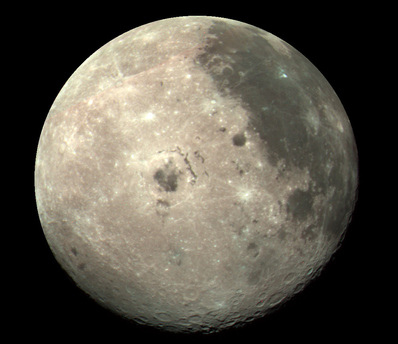Story of the dark side
The 'Dark Side' of the Moon
 © NASA |
The picture was taken by the spacecraft Galileo as it flew past the Moon in 1990. Galileo was able to observe the Moon’s surface from an angle that is not possible from the Earth, due to the fact that the same side of the Moon always faces the Earth.
The reverse side of the Moon can never be seen from Earth.
But why do we only ever see one side of the Moon? In the same way as the Moon causes the ebb and flow of the tides on Earth due to its gravitational pull, the Earth, with a mass of around 81 times that of the Moon, exerts a correspondingly greater force on the Moon. Although it has no liquid oceans that can be moved, the gravitational force of the Earth is large enough to be able to slightly deform the Moon. This in turn slows the Moon's rotation about its axis. Ultimately this slowing down causes what is known as 'connected rotation': the Moon takes the same time to rotate once around its axis as it requires for one orbit around the Earth – and as a result, the same side of the Moon always faces the Earth.
In the past there was always a great deal of wild speculation about what could be hidden on the reverse side of the Moon, that is, on the side that faces away from the Earth. In 1959, the Soviet lunar probe Lunik 3 took the first pictures of the reverse side of the Moon. The first humans to see it with their own eyes were the astronauts on board Apollo 8, in 1968. Unsurprisingly, no alien spaceships or extra-terrestrial moon bases were found there.
Source: German Aerospace Center
Story of the dark side
The 'Dark Side' of the Moon
 © NASA |
The picture was taken by the spacecraft Galileo as it flew past the Moon in 1990. Galileo was able to observe the Moon’s surface from an angle that is not possible from the Earth, due to the fact that the same side of the Moon always faces the Earth.
The reverse side of the Moon can never be seen from Earth.
But why do we only ever see one side of the Moon? In the same way as the Moon causes the ebb and flow of the tides on Earth due to its gravitational pull, the Earth, with a mass of around 81 times that of the Moon, exerts a correspondingly greater force on the Moon. Although it has no liquid oceans that can be moved, the gravitational force of the Earth is large enough to be able to slightly deform the Moon. This in turn slows the Moon's rotation about its axis. Ultimately this slowing down causes what is known as 'connected rotation': the Moon takes the same time to rotate once around its axis as it requires for one orbit around the Earth – and as a result, the same side of the Moon always faces the Earth.
In the past there was always a great deal of wild speculation about what could be hidden on the reverse side of the Moon, that is, on the side that faces away from the Earth. In 1959, the Soviet lunar probe Lunik 3 took the first pictures of the reverse side of the Moon. The first humans to see it with their own eyes were the astronauts on board Apollo 8, in 1968. Unsurprisingly, no alien spaceships or extra-terrestrial moon bases were found there.
Source: German Aerospace Center





